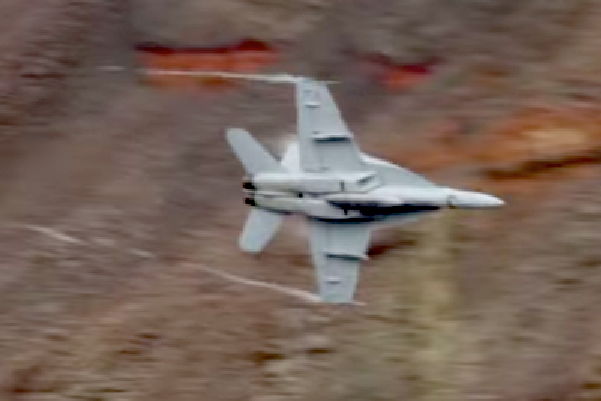
If you’ve ever attended an air show, you know to expect the Navy’s Blue Angels or the Air Force’s Thunderbirds to suddenly roar overhead, hugging the Earth and delightedly scaring young and old alike.
It’s quite a different matter when you’re quietly communing with nature on the ridge of a canyon deep in Death Valley, and a pair of F-18s screams by—flying lower than you, down in the rocky gash.
That’s just what happens in this recently-posted YouTube video. It’s no surprise that the gobsmacked reaction of those on the ground (foul-language alert!) is just as much fun to witness as the F-18 Hornets themselves, which likely came from the nearby Navy’s China Lake Naval Air Weapons Station.
“If there is one thing in this world that can turn a fully grown man into an excited teenage girl,” one viewer enthused, “it’s the sound of two GE F404 engines tearing overhead.”
Such flights, by military and other aircraft, have long been a concern, both for environmental and safety reasons. While it may be exciting, is this the proper use for such a national treasure (in this case the park, not the jets)? You bet, according to the National Park Service, which oversees the 5,200 square-mile California park.
While the FAA urges civilian aircraft to fly no lower than 2,000 feet—and orders them to stay above 500 feet—such altitude restrictions don’t apply to military planes. That’s because much of Death Valley is part of the R-2508 military training complex. “Congress and the FAA have given the military authority to deviate from standard flight regulations in the training complex,” the park service says. Outside of Death Valley itself—which includes many valleys—“the military can fly to within 200 feet of the ground.”
The military services regulate flights over national parks (Air Force, Army), but those rules don’t always apply when the park is part of a military training range.
Military pilots will tell you that flying low amid terrain—to practice hiding from enemy radar—can be good training for possible real-world missions. But such flights—especially outside military ranges—carry risks. In 1998, a Marine EA-6B jet crew was schussing, too fast and too low, through Italy’s Dolomite Mountains. It clipped a ski gondola cable and sent it plummeting more than 300 feet to the ground, killing all 20 aboard. “The aircraft,” the official investigation concluded, “flew lower and faster than authorized wherever the terrain permitted.”
The pilot and navigator were cleared of charges of involuntary manslaughter and negligent homicide. They were later convicted of obstruction of justice and conduct unbecoming an officer for destroying a videotape, perhaps resembling the one from Death Valley, made from the cockpit during the fatal flight through Alpine Valley.
More Must-Reads from TIME
- How Donald Trump Won
- The Best Inventions of 2024
- Why Sleep Is the Key to Living Longer
- Robert Zemeckis Just Wants to Move You
- How to Break 8 Toxic Communication Habits
- Nicola Coughlan Bet on Herself—And Won
- Why Vinegar Is So Good for You
- Meet TIME's Newest Class of Next Generation Leaders
Contact us at letters@time.com